QLLN is a ransomware-type virus released by the STOP/DJVU cybercriminal gang
Contents
QLLN ransomware is a dangerous computer virus that affects vulnerable hosts running Windows OS. It is a variant of the infamous STOP/DJVU ransomware family and is recognized from a 4-character .qlln extension it appends to encrypted file names. To illustrate the renaming procedure, we will provide some examples: 1.jpg becomes 1.jpg.qlln, 2.docx becomes 2.docx.qlln and so on. The computer user soon discovers that encrypted files also have blank icons and are impossible to open.
The aim of QLLN virus is to leverage encryption algorithms to make victim’s personal files inaccessible. This causes frustration for the computer user, since people keep various important data in their personal or work computers – including documents, photos, archives, audio and video files. The ransomware drops _readme.txt files throughout the computer system and these files are widely known as “ransom notes.” They all contain an identical message from the cybercriminals, who assure that the only way to get QLLN file decryption tool is to pay a ransom for threat actors behind the ransomware attack.

_readme.txt contents explained
The cybercriminals reveal their intentions in so-called ransom noted titled as _readme.txt. These files are saved in almost every data folder containing encrypted files. The message in it explains that the ransomware has encrypted all data using strongest encryption algorithms, and that in order to recover these files, the victim has to purchase a special software along unique decryption key from the criminals.
The ransom note also briefs that the initial price of the decryption tools is $980. However, the criminals might reduce the price in half if the victim rushes to contact them within 72 hours starting from the infection timestamp. In other words, for the first 3 full days, threat actors provide a 50% discount on the decryption tools. Any longer, and the demanded ransom amount will bounce back to the initial amount.
The ransom note includes two email addresses – admin@helpdata.top and supportsys@airmail.cc which belong to cybercriminals. Therefore, if the victim wants to open a channel of communication, one needs to send an email using these addresses. The criminals recommend checking spam or junk folders in email in case the victim receives no answer within 6 hours.
After contacting the criminals via email, the victim will discover that the only acceptable form of payment involves blockchain-based transactions, therefore one will need cryptocurrency to pay the ransom. The criminals will provide their virtual wallet address where the money should be sent. The reason why Internet criminals rely on cryptocurrencies is that it helps them to keep their identity private.

Experts from our team do not recommend paying the ransom to cybercriminals. You can also read these official FBI ransomware recommendations that also matches our advice. Here are some good reasons why paying the ransom is simply not worth the risk:
- The criminals may vanish into thin air after receiving your money;
- Cybercriminals often have a tendency to repeatedly blackmail victims who have paid at least once;
- Paying the ransom fuels the ransomware cycle and helps to produce even more malware.
Additional damage inflicted on compromised computer
STOP/DJVU ransomware rarely travels alone – submissions to VirusTotal and App.Any.Run platforms show that it mostly travels along Vidar or Azorult Trojans. These are highly prevalent information-stealing Trojans with remote access functionality. In short, they can be used by cybercriminals to perform various illegal activities on victim’s computer, mostly those related to sensitive data extraction and theft.
The illegal activities that these Trojans were designed for include:
- Exfiltrating system information, browser data, saved login credentials, browsing history, cookies and more;
- Stealing app login information;
- Viewing, deleting files or downloading additional ones to computer.
On top of that, the ransomware has a tendency to delete Volume Shadow Copies from the computer in order to prevent the victim from restoring encrypted files with ease. The virus might also perform various other modifications to establish persistence on the infected system.
In order to stop the malware from damaging your computer system and files stored on it, we recommend that you remove QLLN ransomware virus as soon as you can. The best way to do this is to boot your computer system in Safe Mode with Networking – which is an ideal environment for malware removal – and run an up-to-date antivirus software to do its job. Once the threat is removed, we recommend downloading RESTORO (see its review here) to identify and repair virus damage to Windows OS files.
Ransomware Summary
| Name | QLLN Ransomware Virus |
| Type | Ransomware; Crypto-malware; Virtual Extortion Virus |
| Family | STOP/DJVU |
| Encryption type | RSA 2048 + Salsa20 |
| Previous versions | KAAA, BGJS, BGZQ (find full list here) |
| Version | 487th |
| Extension | .qlln |
| Cybercriminal emails | admin@helpdata.top and supportsys@airmail.cc |
| Additional malware dropped | Azorult or Vidar Trojan |
| Damage | The ransomware uses encryption to maliciously modify all files on the PC and marks their original names with .qlln extension. Ransom notes called as _readme.txt will be dropped in every computer folder. This piece of malware usually drags VIDAR Stealer alongside it and also eliminates VSS from the system. On top of that, it tends to modify Windows HOSTS file to restrict computer user’s access to cybersecurity-related websites online. |
| Ransom note | _readme.txt |
| Ransom demand | $490-$980 in Bitcoin |
| Distribution | Victims often download this ransomware along illegal torrent downloads, cracked software, activators, key generators or tools like KMSPico. |
| Known software cracks to contain this malware | Corel Draw, Tenorshare 4ukey, Adobe Photoshop, Cubase, Adobe Illustrator, Internet Download Manager, Tally, League of Legends. |
| Detection names | Ransom:Win32/StopCrypt.PAL!MTB (Microsoft), Trojan.Crypt (A) (Emsisoft), HEUR:Trojan-Ransom.Win32.Stop.gen (Kaspersky), Trojan.GenericKD.47850419 (BitDefender), Trojan.MalPack.GS (Malwarebytes), ML.Attribute.HighConfidence (Symantec) see all detection name variations on VirusTotal |
| Removal | Remove ransomware and related malware from your PC using trustworthy software. To repair virus damage on Windows OS files, consider scanning with RESTORO (secure download link). |
REPAIR VIRUS DAMAGE
Scan your system for FREE to detect security, hardware and stability issues. You can use the scan results and try to remove threats manually, or you can choose to get the full version of software to fix detected issues and repair virus damage to Windows OS system files automatically. Includes Avira spyware/malware detection & removal engine.
See a screenshot of files encrypted by this ransomware in a folder.

Ransomware distribution and prevention
Ransomware-type viruses are distributed via illegal downloads, drive-by downloads, phishing emails, targeted attacks or malvertising. When it comes to STOP/DJVU ransomware family, it spreads its variants such as QLLN virus via deceptive online downloads presented as cracked premium software versions. These can be found in warez and torrent sites and accessible via peer-to-peer file sharing agents or downloaded directly via automatically generated link. The vast majority of these downloads include a password-protected archive with a malicious setup.exe file inside.
We advise computer users to stay vigilant when looking for websites to download software from. Make sure you choose trustworthy and reputable online resources. Ideally, visit sites that belong to official software developers since they can provide you with 100% legitimate and functional software versions risk-free. Besides, remember that trying to download pirated software versions is an act of a copyright infringement.
Threat actors also hide ransomware-type viruses in popular document formats like DOCX, PDF, or XLS and name these files as Invoices/Payment Details/Order Summaries/Waybills etc. only to attach them to convincing emails and distribute these to thousands of victims. Therefore, we advise computer users to be very cautious when checking the email and stay away from letters that have an urgent tone suggesting to view attached contents/click on provided URLs. Another detail that’s worth mentioning is that cybercriminals often use scare tactics and their email subjects are usually similar to ones listed below:
- Your account might get closed;
- Your email will get deactivated;
- Problem with bank account;
- Your order receipt;
- You must change your password immediately.
If you open the attached file out of pure curiosity, your computer will get compromised in no time. For this reason, we recommend that you avoid suspicious emails and in general emails sent by unknown or unexpected parties altogether.
Finally, victims of this malware should avoid visiting scam websites suggesting they can provide a solution to STOP/DJVU online key encryption victims. These sites might be promoting another malware disguised as a data recovery tool. Moreover, keep in mind that there are many scammers on social media platforms claiming they know a hacker who can help you – these are simply scams that might try to rip you off financially. For confirmed and currently official ways to restore/repair files locked by this ransomware strain, visit this guide.
Remove QLLN Ransomware Virus and Decrypt Your Files
Follow the instructions provided below to learn how to remove QLLN ransomware virus along other malware installed on your computer. Make sure you complete each step carefully. Use a trusted antivirus solution of your choice, although we strongly recommend to download and scan with RESTORO as a bonus step. This tool is known for its capabilities to repair virus-damaged Windows OS files successfully.
Once QLLN virus removal is finished, do not forget to change all of your passwords that you used on the compromised computer.
OUR GEEKS RECOMMEND
Our team recommends removing malware using a professional antivirus software.
REMOVE THREATS WITH ROBUST ANTIVIRUS

Get INTEGO ANTIVIRUS for Windows to remove ransomware, Trojans, adware and other spyware and malware variants and protect your PC and network drives 24/7. This VB100-certified security software uses state-of-art technology to provide protection against ransomware, Zero-Day attacks and advanced threats, Intego Web Shield blocks dangerous websites, phishing attacks, malicious downloads and installation of potentially unwanted programs.
Use INTEGO Antivirus to remove detected threats from your computer.
GeeksAdvice.com editors select recommended products based on their effectiveness. We may earn a commission from affiliate links, at no additional cost to you. Learn more.
QLLN Ransomware Virus Removal Guidelines
Method 1. Enter Safe Mode with Networking
Step 1. Start Windows in Safe Mode with Networking
Before you try to remove QLLN Ransomware Virus virus, you must start your computer in Safe Mode with Networking. Below, we provide the easiest ways to boot PC in the said mode, but you can find additional ones in this in-depth tutorial on our website – How to Start Windows in Safe Mode. Also, if you prefer a video version of the tutorial, check our guide How to Start Windows in Safe Mode on Youtube.
Instructions for Windows XP/Vista/7 users
- First of all, turn off your PC. Then press the Power button to start it again and instantly start pressing F8 button on your keyboard repeatedly in 1-second intervals. This launches the Advanced Boot Options menu.
- Use arrow keys on the keyboard to navigate down to Safe Mode with Networking option and press Enter.

Instructions for Windows 8/8.1/10/11 users
- Open Windows Start menu, then press down the Power button. On your keyboard, press down and hold the Shift key, and then select Restart option.

- This will take you to Windows Troubleshoot screen. Choose Troubleshoot > Advanced Options > Startup Settings > Restart. Tip: If you can't find Startup Settings, click See more recovery options.

- In Startup Settings, press the right key between F1-F9 to enter Safe Mode with Networking. In this case, it is the F5 key.

Step 2. Remove files associated with the virus
Now, you can search for and remove QLLN Ransomware Virus files. It is very hard to identify files and registry keys that belong to the ransomware virus, Besides, malware creators tend to rename and change them repeatedly. Therefore, the easiest way to uninstall such type of a computer virus is to use a reliable security program such as INTEGO Antivirus. For virus damage repair, consider using RESTORO.
Special Offer
Compatibility: Microsoft Windows
See Full Review
RESTORO is a unique PC Repair Tool which comes with an in-built Avira scan engine to detect and remove spyware/malware threats and uses a patented technology to repair virus damage. The software can repair damaged, missing or malfunctioning Windows OS files, corrupted DLLs, and more. The free version offers a scan that detects issues. To fix them, license key for the full software version must be purchased.
Method 2. Use System Restore
In order to use System Restore, you must have a system restore point, created either manually or automatically.
Step 1. Boot Windows in Safe Mode with Command Prompt
Instructions for Windows XP/Vista/7 users
- Shut down your PC. Start it again by pressing the Power button and instantly start pressing F8 button on your keyboard repeatedly in 1-second intervals. You will see Advanced Boot Options menu.
- Using arrow keys on the keyboard, navigate down to Safe Mode with Command Prompt option and press Enter.

Instructions for Windows 8/8.1/10/11 users
- Launch Windows Start menu, then click the Power button. On your keyboard, press down and hold the Shift key, and then choose Restart option with the mouse cursor.

- This will take you to Windows Troubleshoot screen. Choose Troubleshoot > Advanced Options > Startup Settings > Restart. Tip: If you can't find Startup Settings, click See more recovery options.

- In Startup Settings, press the right key between F1-F9 to enter Safe Mode with Command Prompt. In this case, press F6 key.

Step 2. Start System Restore process
- Wait until system loads and command prompt shows up.
- Type cd restore and press Enter, then type rstrui.exe and press Enter. Or you can just type %systemroot%system32restorerstrui.exe in command prompt and hit Enter.

- This launches System Restore window. Click Next and then choose a System Restore point created in the past. Choose one that was created before ransomware infection.

- Click Yes to begin the system restoration process.
After restoring the system, we recommend scanning the system with antivirus or anti-malware software. In most cases, there won't be any malware remains, but it never hurts to double-check. In addition, we highly recommend checking ransomware prevention guidelines provided by our experts in order to protect your PC against similar viruses in the future.
Alternative software recommendations
Malwarebytes Anti-Malware
Removing spyware and malware is one step towards cybersecurity. To protect yourself against ever-evolving threats, we strongly recommend purchasing a Premium version of Malwarebytes Anti-Malware, which provides security based on artificial intelligence and machine learning. Includes ransomware protection. See pricing options and protect yourself now.

System Mechanic Ultimate Defense
If you're looking for an all-in-one system maintenance suite that has 7 core components providing powerful real-time protection, on-demand malware removal, system optimization, data recovery, password manager, online privacy protection and secure driver wiping technology. Therefore, due to its wide-range of capabilities, System Mechanic Ultimate Defense deserves Geek's Advice approval. Get it now for 50% off. You may also be interested in its full review.

Disclaimer. This site includes affiliate links. We may earn a small commission by recommending certain products, at no additional cost for you. We only choose quality software and services to recommend.
Decrypt QLLN files
Fix and open large QLLN files easily:
It is reported that STOP/DJVU ransomware versions encrypt only the beginning 150 KB of each file to ensure that the virus manages to affect all files on the system. In some cases, the malicious program might skip some files at all. That said, we recommend testing this method on several big (>1GB) files first.
- Create a copy of encrypted file to a separate folder using Copy > Paste commands.
- Now, right-click the created copy and choose Rename. Select the QLLN extension and delete it. Press Enter to save changes.
- In the prompt asking whether you want to make the changes as file might become unusable, click OK.
- Try opening the file.
STOP/DJVU decryption tool usage guide
STOP/DJVU ransomware versions are grouped into old and new variants. QLLN Ransomware Virus is considered the new STOP/DJVU variant, just like KAAA, BGJS, BGZQ (find full list here). This means full data decryption is now possible only if you have been affected by offline encryption key. To decrypt your files, you will have to download Emsisoft Decryptor for STOP DJVU, a tool created and maintained by a genius security researcher Michael Gillespie.
Note! Please do not spam the security researcher with questions whether he can recover your files encrypted with online key - it is not possible.
In order to test the tool and see if it can decrypt QLLN files, follow the given tutorial.
- Download the decryption tool from Emsisoft.
- Click the little arrow next to your download and choose Show in Folder.
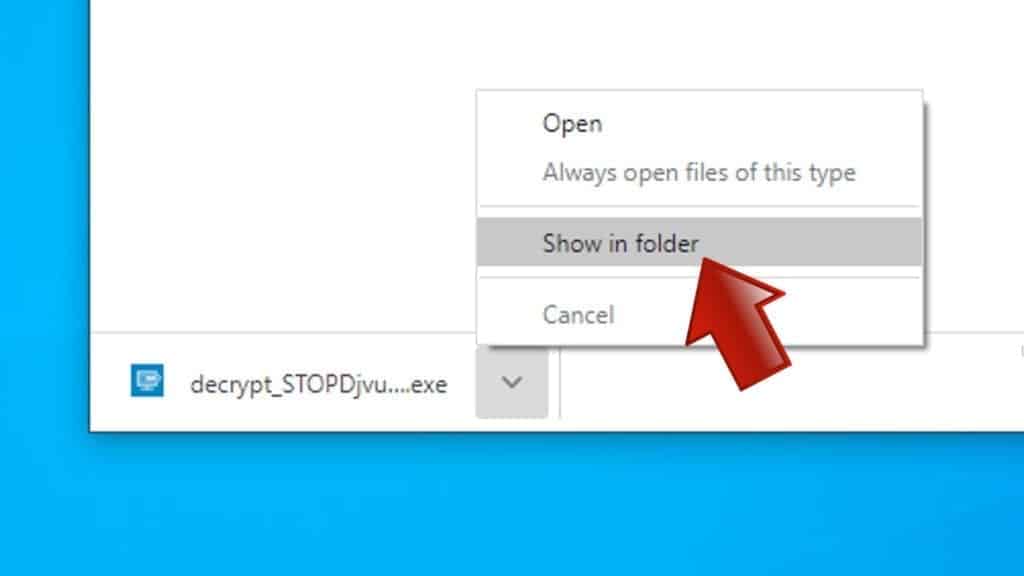
- Now, right-click the file and choose Run as Administrator. If asked, enter administrator's password.
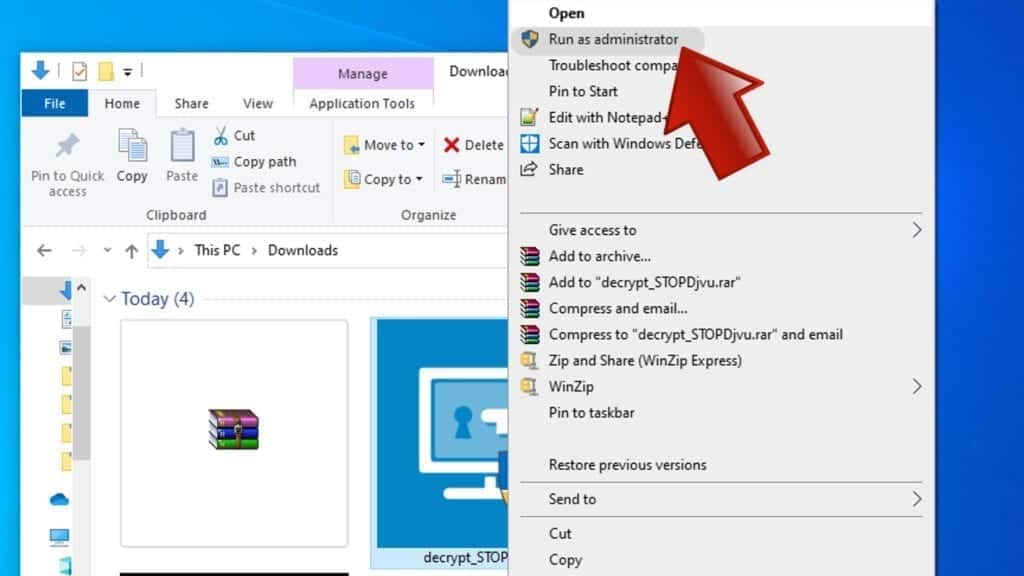
- In UAC window, click Yes.
- Click Yes to agree to software terms in both windows.
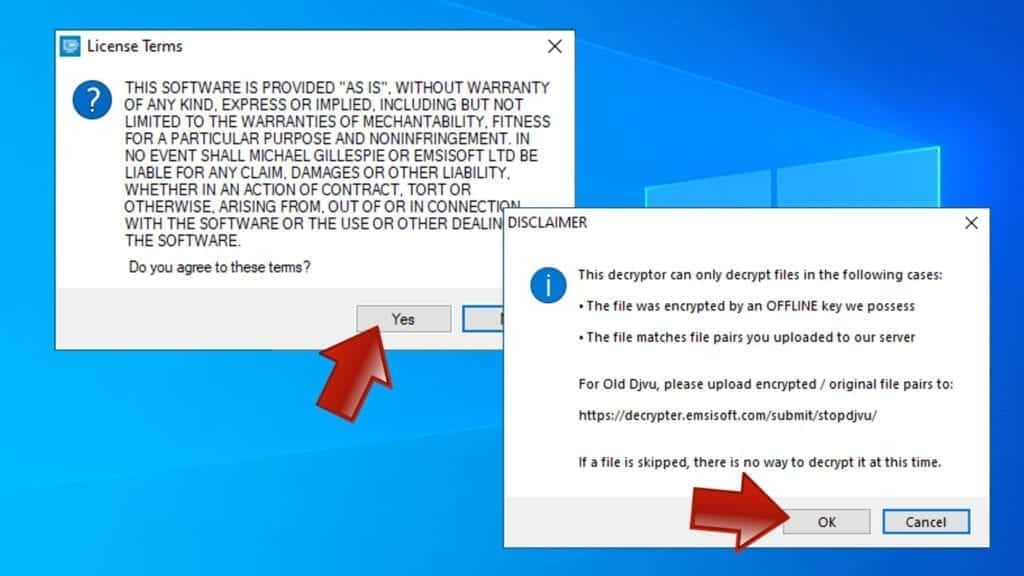
- The tool will automatically include C:// disk as a location to decrypt. The file recovery tool will prepopulate the locations to scan, including connected data storage drives or network drives. Click Add folder if you wish to add additional locations.
In Options tab, you can choose to keep encrypted file copies. We recommend leaving this option selected, especially if you do not know if the decryption tool will work.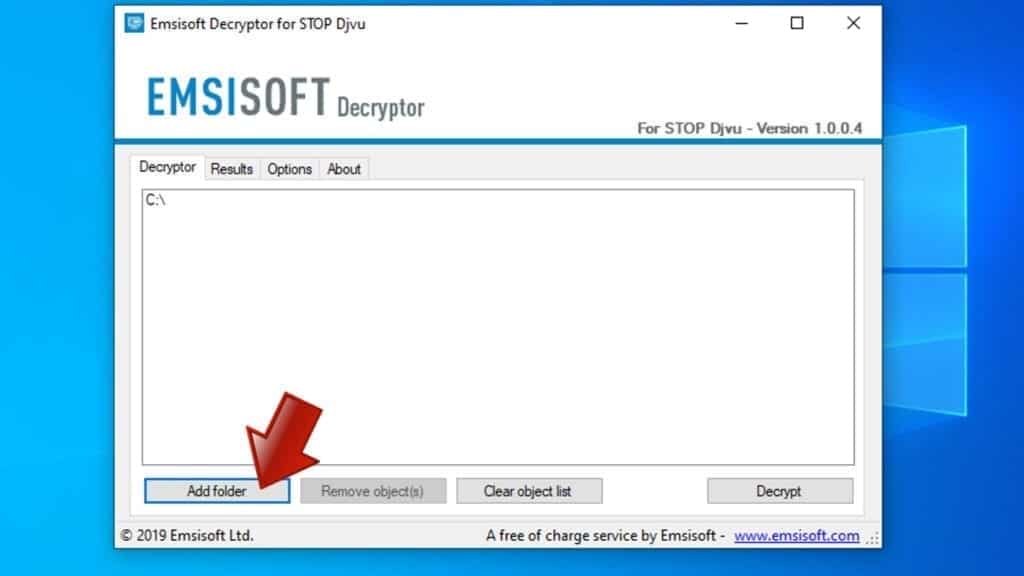
- Click Decrypt to start restoring QLLN files. You will see the progress in the Results tab. Here, you can see messages from the tool, such as whether the decryption procedure is successful, or you need to wait for an update.
You might also be informed that online key was used to encrypt your files. In such case, the decryption tool won't work for you, and the only way to recover your files is to use a data backup.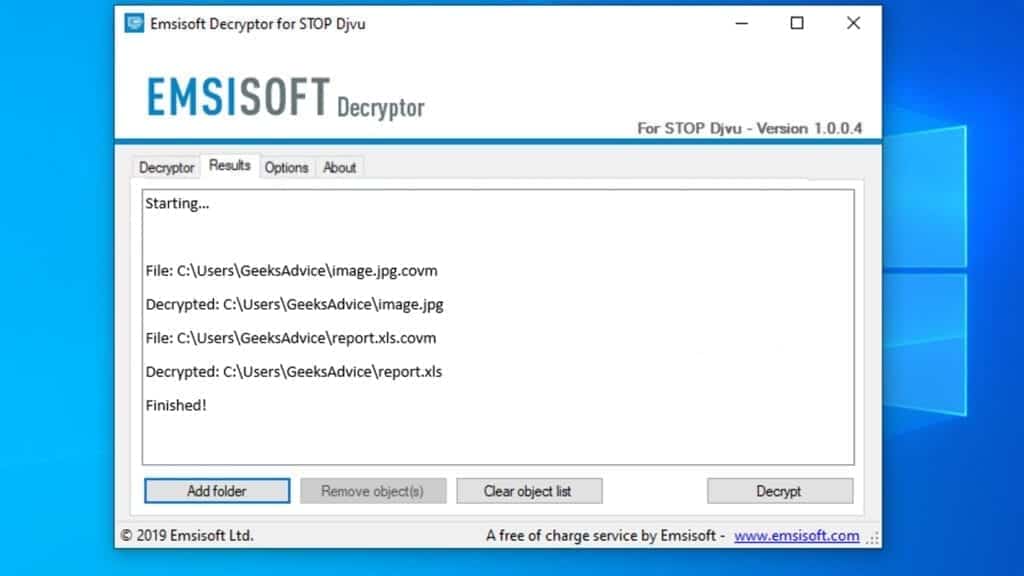
Meanings of decryptor's messages
The QLLN decryption tool might display several different messages after failed attempt to restore your files. You might receive one of the following messages:
Error: Unable to decrypt file with ID: [example ID]
This message typically means that there is no corresponding decryption key in the decryptor's database.
No key for New Variant online ID: [example ID]
Notice: this ID appears to be an online ID, decryption is impossible
This message informs that your files were encrypted with online key, meaning no one else has the same encryption/decryption key pair, therefore data recovery without paying the criminals is impossible.
Result: No key for new variant offline ID: [example ID]
This ID appears to be an offline ID. Decryption may be possible in the future.
If you were informed that an offline key was used, but files could not be restored, it means that the offline decryption key isn't available yet. However, receiving this message is extremely good news, meaning that it might be possible to restore your QLLN extension files in the future. It can take a few months until the decryption key gets found and uploaded to the decryptor. We recommend you to follow updates regarding the decryptable DJVU versions here. We strongly recommend backing up your encrypted data and waiting.
Report Internet crime to legal departments
Victims of QLLN Ransomware Virus should report the Internet crime incident to the official government fraud and scam website according to their country:
- In the United States, go to the On Guard Online website.
- In Australia, go to the SCAMwatch website.
- In Germany, go to the Bundesamt für Sicherheit in der Informationstechnik website.
- In Ireland, go to the An Garda Síochána website.
- In New Zealand, go to the Consumer Affairs Scams website.
- In the United Kingdom, go to the Action Fraud website.
- In Canada, go to the Canadian Anti-Fraud Centre.
- In India, go to Indian National Cybercrime Reporting Portal.
- In France, go to the Agence nationale de la sécurité des systèmes d’information.
If you can't find an authority corresponding to your location on this list, we recommend using any search engine to look up "[your country name] report cyber crime". This should lead you to the right authority website. We also recommend staying away from third-party crime report services that are often paid. It costs nothing to report Internet crime to official authorities.
Another recommendation is to contact your country's or region’s federal police or communications authority.
Frequently Asked Questions
You can only open QLLN files if you have the decryption key, or if you were affected by offline encryption type.
To figure out whether you were affected by offline encryption, please go to C:/SystemID/PersonalID.txt and see if the string inside of it ends in t1. You can also try using Emsisoft Decryptor for STOP/DJVU.
Please follow the guidances provided by the official QLLN decryption tools and believe what they say. If they say it is impossible to decrypt, it really is so. There is no magic tool or human capable of decrypting your files hiding somewhere. Encryption is a technique created to be nearly impossible to decrypt without a special private key (held by the criminals).
We advise scanning with anti-virus, anti-malware, malware removal tools or software like RESTORO to eliminate virus damage on the system. If you do not trust using a single tool, try running one after another. However, we do not recommend keeping several security programs on a computer at once as they can interfere with each other's work.
Beware of fake QLLN decryption tools circulating around the web. Cyber criminals are uploading them to various shady websites, also might be promoting them via suspicious Youtube videos. These programs can infect your computer even more heavily (Trojans, miners, etc.). We suggest being extremely cautious around the web. If there will be an official STOP/DJVU decryption tool available, it will be widely discussed in public media.

Norbert Webb is the head of Geek’s Advice team. He is the chief editor of the website who controls the quality of content published. The man also loves reading cybersecurity news, testing new software and sharing his insights on them. Norbert says that following his passion for information technology was one of the best decisions he has ever made. “I don’t feel like working while I’m doing something I love.” However, the geek has other interests, such as snowboarding and traveling.
Leave a Reply